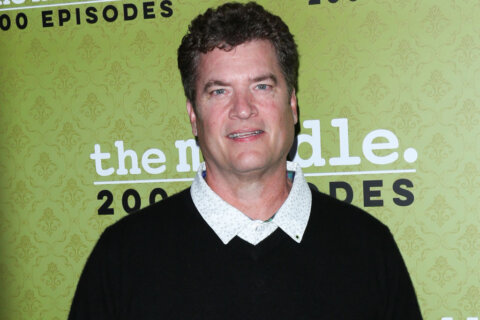WASHINGTON — To see a restored film is to see it for the first time.
Too many folks assume that watching a decades-old movie will mean a grainy image, poor sound and a dated viewing experience — recalling faded reruns of old television shows. But when properly restored, a classic movie looks just as vibrant — if not more vibrant — than anything in theaters today.
This Friday, get ready for stunning 4K restorations of classic movies at two D.C. area theaters.
First, the AFI Silver Theatre in Silver Spring, Maryland is screening Carol Reed’s “The Third Man” (1949), following a pulp novelist (Joseph Cotten) who visits postwar Vienna to investigate the death of an old friend, black-market schemer Harry Lime (Orson Welles). Arguably the best British movie ever made, this shadowy noir masterpiece features a number of legendary scenes, from a ferris-wheel debate, to the sewer climax, to the final shot in the tree-lined cemetery (referenced in “The Departed”). It screens for a week starting June 26 as part of the theater’s Orson Welles Centennial.
Meanwhile, the E Street Cinema in downtown D.C. screens Satyajit Ray’s “The Apu Trilogy” — consisting of “Pather Panchali” (1955), “Aparajito” (1957) and “The World of Apu” (1959) — following a free-spirited child in rural Bengal who matures into an adolescent urban student and finally a sensitive man of the world. Undoubtedly the most important films ever to come out of India, the trilogy will be shown with separate admissions from June 26 to July 2.
“I’m envious of the person that’s going to see these, because they’re gonna feel like they’re seeing something brand new,” says Lee Kline, technical director for the Criterion Collection. “We know that resolution of 4K is very close to film resolution. We estimate film resolution to be somewhere around 5K, so when you do a 4K scan, you really are getting most of the resolution out of that film.”
Kline oversaw the “Apu” restoration, a mini miracle considering the films were literally pulled from a fire. In 1993, a nitrate explosion in London was thought to have destroyed the original negatives. Turns out, the charred remains were sent to the Academy of Motion Picture Arts and Sciences in Los Angeles, where they remained locked in a vault for 20 years.
In 2013, Kline was invited to come look inside the cans.
“We literally saw burnt pieces of film,” Kline says. “You couldn’t even pick some of the reels up because they were brittle and they were flaking off. … Most people would put the cover back on the box and say, well, we’re not going to be able to do this. But we thought these are here for a reason, so let’s at least see what’s between the sprockets and see if there’s actually a good image there.”
So, they gathered the reel that appeared to be in the best condition and persuaded the Sony film lab to scan 60 seconds — just as a test run.
“We had a look and said, ‘Whoa, this is pretty exciting!’ But we were probably overzealous, because that wasn’t indicative of the rest of the movie,” Kline says.
It quickly became clear that this would be quite the undertaking.
“A typical restoration is: you find the best film, you scan it at a high resolution, and then you use your digital tools to clean it up afterward,” Kline says. “In this case, we couldn’t even get to that step until we fixed the (physical) film. Because if the film wasn’t repaired, you couldn’t even get a scan out of it.”
So, the damaged film reels spent the next few months at a special lab in Bologna, Italy, where preservationists spent a thousand hours making physical repairs: removing sprockets, fixing splices, rehydrating the film and flattening out warped segments — until it was finally ready to scan.
“We had to really discard quite a bit of the movies, because we couldn’t really repair them,” he says.
The discarded pieces were replaced by duplicate prints, made over the years. Think of it as “Jurassic Park” technicians filling in dinosaur DNA sequence gaps with frog genes. Kline used as much of the original film negatives as possible, then filled in the rest with duplicate material.
In the end, original negatives were used for 40 percent of “Pather Panchali” 60 percent of “Aparajito” and, unfortunately, zero of “The World of Apu.” The third installment had been burnt the most, but luckily, it was the newest in the trilogy, so decent replicas existed for the scan.
Now, the 4K restoration is complete and ready for your enjoyment at E Street Cinema. For cinephiles, it’s a chance to rediscover a masterpiece of world cinema, now looking better than ever. For average moviegoers, it’s the perfect time for an introduction to the art-house glory of Ray.
“Satyajit Ray is far too little known,” says Peter Becker, president of the Criterion Collection. “These films represent the postwar flowering of a truly global, international cinema consciousness where people are seeing direct expressions by the places that are very far away. Rather than making them seem exotic, they made them seem universal and understandable. … The arts, and particularly cinema, became a very important way of us getting to know each other around the world.”
In many ways, Ray marks a bridge between the Eastern and Western worlds. The Calcutta native met French filmmaker Jean Renoir during his visit to India to make “The River” (1951), upon which Ray volunteered to help scout locations. Ray also visited England for six months on an advertising job, where he watched 99 films with his wife. His mind was blown by Vittorio De Sica’s “Bicycle Thieves” (1948), causing him to return to Bengal wanting to make India’s version of Italian Neorealism, shooting with an uber-naturalistic style contrasting with Hollywood production values.
“Even though the camerawork seems very understated, what it sees is really beautiful,” Becker says. “His rhythms are very peculiar and interesting. They’re not like other filmmakers.”
How ironic that Ray’s career was inspired by a trip to England, decades before his masterpiece trilogy was nearly incinerated by a London fire. But it makes it all the more fitting that his remastered work comes to D.C. the same day that Britain’s crowned jewel “The Third Man” shows across town.
“You got some really good choices to make there,” Kline says, beaming at our good fortune. “If you’re lucky enough to see (‘Apu’) on a 4K projector, your mind is going to blown. When we saw it for the first time in 4K, we sat there with our mouths open. … Go out there and see ‘The Apu Trilogy.’ You will be moved and know that you’re watching a great piece of art.”
As legendary Japanese filmmaker Akira Kurosawa put it: “To have not seen the films of Ray is to have lived in the world without ever having seen the moon and the sun.”
Imagine the sun and moon in 4K, baby.








